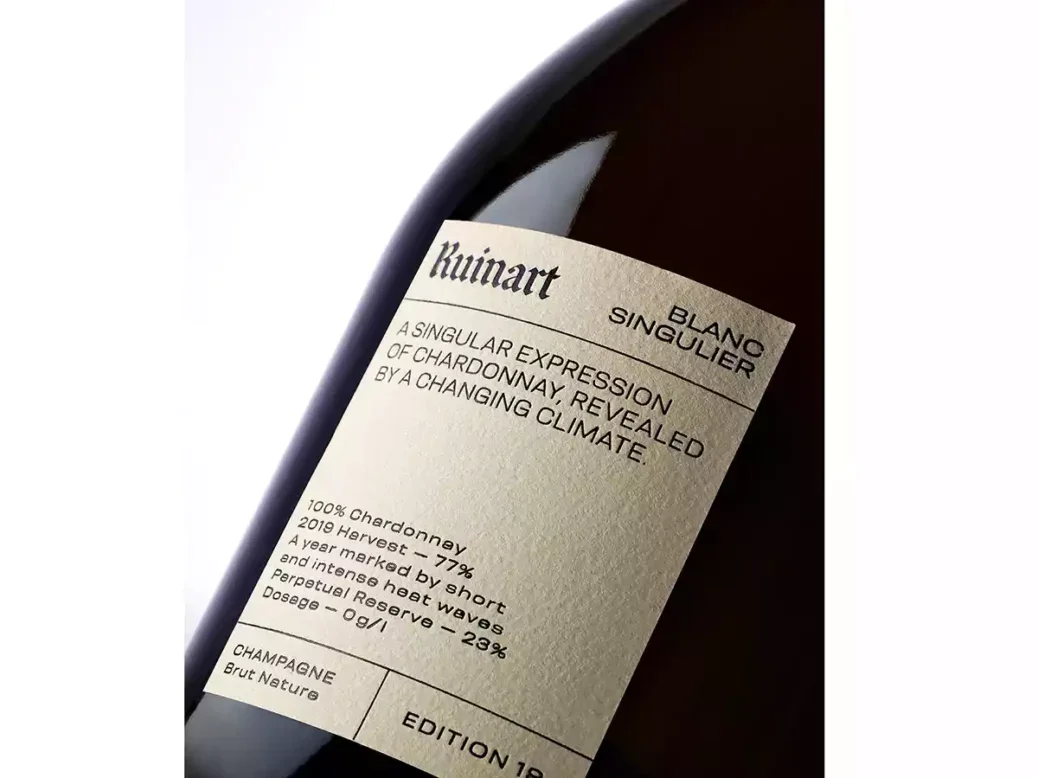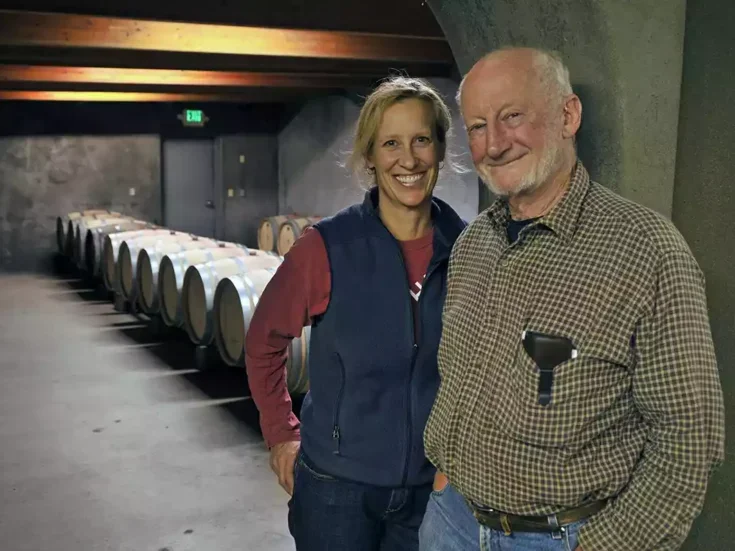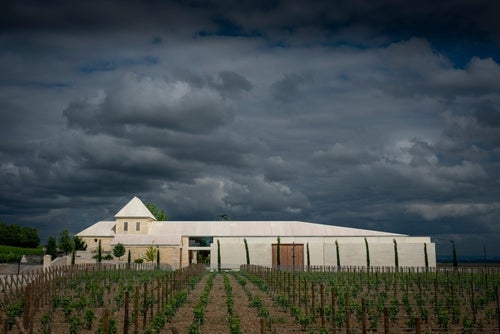
Ruinart has joined the party—the very deluxe party with fellow guests such as Roederer, Moët & Chandon, Krug, and Jacquesson, the party that dares to defy the hegemony of Non-Vintage Champagne built on the paradox of putative consistency, the party hitherto dependent on the reassurance of the familiar, of the house style, and therefore of a focus on brand equity. Its new Blanc Singulier label is the first addition to the Ruinart portfolio in more than two decades.
Ruinart uses the name Singulier to distinguish different cuvées of blanc de blancs, although the generic, “consistent” blanc de blancs will still exist and will still make up the majority of its production (at least for a while), as with Moët & Chandon Brut Imperial, which bestrides the much smaller Moët Collection. The best of both worlds, one may think. And one may also think that the name Singulier is a little more helpful than, say, “edition” or “collection.” Individuality is key here, after all, and has come so sharply into focus of late, according to cellar master Frédéric Panaïotis, because of the recent radical changes of climate evidenced in his region. Indeed, even the label of the Singulier is chiseled with the words, “A singular expression of Chardonnay revealed by changing climate.” The Singulier series, will, according to Frédéric, unfurl to reflect the rhythm of the years, thereby capturing the essence of all that Ruinart has stood for since 1729, encapsulated by the desire to absorb and to reflect “the freshness and the luminosity of the Chardonnay grape.”
That’s easier said than done, maybe, and it is only partly in jest that Frédéric compares Champagne’s climate in years such as 2018 and 2019 with the southerly vineyards of Châteauneuf-du-Pape. Frédéric notes that while the timing of budbreak has not changed significantly, the flowering date has advanced appreciably over the past decade, and thereafter the gap between flowering and harvest has itself been reduced, the putative ideal of 100 days now more usually closer to 90. The increasing prevalence of August harvests means that the key ripening period is influenced by longer hours of light and more intense sunshine; this has an effect on the acid accumulation (especially malic acid) and on the phenological ripeness. This, is turn, has an effect on the structure of the musts and thereafter on the methods employed in the winery. No need to panic yet, says Frédéric, but there is, he feels, justification in witnessing and demonstrating the increasing climate divergence (2013 and 2021 are so very different from 2018, for example) by the segregation of the wines and the introduction of the Singulier series.
Panaïotis feels that if the potential alcohol at harvest gets over 11% then there may be cause for concern. 10% is seen as fine, the more so if the acidity can hold up. He thinks that the current rain patterns, allied to the very special structure of the chalk of Champagne, mean that the wines can still hold their own, and that the all-important tension can be engendered in the musts and then the wines during and after the tirage. Indeed, at the moment, there are no plans at Ruinart to try to suppress the malolactic fermentation, or to radically change the elévage regime. The use of reserve wines (perpetual reserve in the case of Singulier) is helpful, of course, though in these early days, its use has been relatively modest. This, despite the fact that the temperature hit a record of 108°F (42.3°C) in June 2019. Frédéric reveals that the Huglin Index (which measures degree-days of sunshine) has moved the categorization of Champagne from a “cool” climate to a “moderate” one, and underlines once again the incipient dangers to inherent complexity of a more compact growing season. There is no point comparing today with the hottest years of the past, he says, citing 1976, 1959, and 1949—everything is “completely different.” The silver lining is that we are unlikely ever again to see disasters of the ilk of 1965, 1972, or 1977. Nonetheless, he adds, 2024 is proving quite challenging! One would be unwise to try to second-guess nature.
The first Singulier cuvée was based on 2018 and was made in such small volume that it was restricted to the US and part of the French market, mainly distributed through the on-trade. The new release, the 2019, has added the UK to its marketplace. Singulier is the first new Ruinart cuvée for 20 years, and it has been created, according to Fréd, in order to capture and preserve the ever more pronounced aromatic of Chardonnay and its increasingly complex texture. The Chardonnay in S19 has been sourced from 20 crus, predominantly (interestingly) from the Montagne de Reims (Sillery and Taissy) but also from the Côte des Blancs (Bergères-lès-Vertus and Cramant), the Marne Valley (Dizy), and also, a little farther to the south, from the Vallée du Petit Morin (Villevenade) and the Sézanne (Couvrot and Bassuet). Some 23% of reserve wines, from a perpetual reserve created in 2017, has been included, of which half has been oak-aged. The wine was disgorged in the spring of 2024 and is released without dosage—itself telling, since the generic blanc de blancs contains 7g of sugar per liter. Small production thus far, with the prospect of a 2020 and a 2022, but no 2021 or 2023. A very singular statement, then, and quite a challenge to set oneself—the task of preserving freshness—all the more so in such a demonstrably warm year. Two hot years, indeed, as 2018, despite fewer heat spikes, was overall the warmer of the pair. The young wine bristles with promise and self-belief; its texture impresses, as does the definition on the finish. This is a worthy addition to the Ruinart canon.
2013 Dom Ruinart
And now for a more than interesting comparison to the other new release, the 2013 Dom Ruinart—all Chardonnay, too, of course, but the child of a very different vintage, which is “on the up” in terms of reputation, its chiseled classicism evolving very nicely, especially in the face of the warmer years that were to follow. 2013 was one of the few years that Frédéric feels it is fair to compare with the style of old, its late cycle and harvest, which ran well into October, reminding him of the 1988 vintage. Sourced mainly from the Côte des Blancs (80%) and, therefore, immediately different from the Singulier, the Dom benefits from a far longer tirage (nine years) and, since 2020, from a sojourn on cork, which Frédéric prefers for wines such as these that will enjoy a longer-term evolution. “This is my Chablis,” he jokes, reminding us that despite the relatively cool conditions in play, the potential alcohol at harvest was still an impressive 9.9 degrees, this matched by an equally notable total acidity of 8.4g/l (as H2SO4). Balance is all, he maintains, citing this as the reason why he did not make the wine in 2008 or 2012, both of which he describes as too “austere” for Chardonnay. The 2013 is his vin de plaisir—a Corton-Charlemagne simulacrum, he decides, upgrading his point of reference. It was disgorged in February 2023, and the dosage is 5.5g/l—again tellingly, given that the Singulier is a brut nature. When asked how much Dom Ruinart is made, he provides the usual answer—namely, that its production represents 2% of Ruinart’s total, which might have been more helpful if he had revealed what that figure was! Not huge volumes, in any event, and far, far more modest than the wine made by the other bibulous Dom.
This was a very instructive tasting, as usual, with Frédéric. The Chardonnays could not be more different, with both nature and nurture conspiring to demonstrate the supreme versatility of the variety in radically different circumstances. The very fact that the difference is so pronounced provides an elegant and effortless justification for the introduction of the new Singulier cuvée. Plurality is born out of singularity, without for a moment sacrificing Ruinart’s calling card, which descants in praise of the best Chardonnay.
Tasting
LVMH, London; July 3, 2024
Ruinart Blanc Singulier Edition 18
(100% Chardonnay; 20% perpetual reserve; dosage 0g/l; disgorged March 2023)
A rich gilded wine, deep of color and profound of intent. An intriguing nose marries umami, honeysuckle, and even a touch of lavender. There are tropical elements entwined with lemongrass and sourdough on the palate, an expressive, almost phenolic texture, and a hint of bitterness on the finish. Robust and gastronomic, the heady vintage conditions tamed but clearly evidenced. | 93
Ruinart Blanc Singulier Edition 19
(100% Chardonnay; 23% perpetual reserve; dosage 0g/l; disgorged March 2024)
Appreciably different from its forebear; there is more precision and focus here. Lighter in hue, an initial reduction soon dissipated, with a legacy of green and citric fruit. A soft, gently honeyed texture and more red-fruit character than one has the right to expect from a blanc de blancs (a function of youth in all probability). Thereafter, the white fruits take over, spice and smoke in support; also jasmine and a sturdy chalky subtext, once again betraying youth and potential in equal measure. This one will be fascinating to track, especially over the next three to five years. | 94
2013 Dom Ruinart
(100% Chardonnay; dosage 5.5g/l;
disgorged February 2023)
A dignified ocher-green hue, with a delicate mousse and an evocative nose, recalling hearthside, peat, sour honey, and autumn evenings. Delightful! On the palate, lemongrass is rejoined by hints of nectarine, mace, and mirabelle plum, then white pepper and a hint of cardamon, complexity underwritten by the aging under cork rather than crown cap. A rare crystalline elegance, a momentary recollection of Champagnes of yore at their very best: nuanced, supple, delicate, short, incalculably brilliant. | 96+






